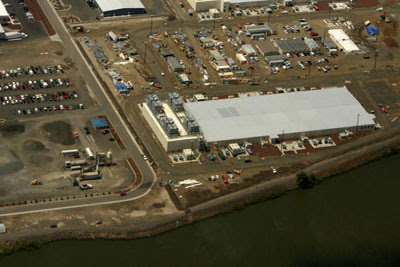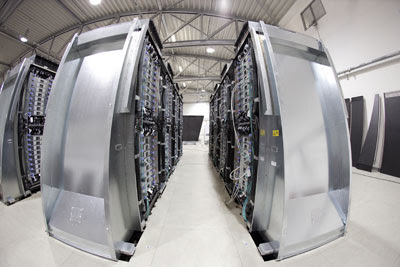Google-Apple Cloud Computer
In his new book "The Big Switch: Rewiring the World, from Edison to Google," computer industry writer and former executive editor of the Harvard Business Review Nicholas G. Carr discusses the changes he sees in the future of computing. One of the more dramatic changes is a shift to cloud computing -- where applications and files are stored on a large, centralized supercomputer or network. The end user accesses his or her files using computers that are more streamlined but less sophisticated than today's typical machines.
 Nicholas Carr, seen here at a Sun Network Conference in 2003, believes that tech giants Apple and Google may be on the verge of creating a cloud computer.
Nicholas Carr, seen here at a Sun Network Conference in 2003, believes that tech giants Apple and Google may be on the verge of creating a cloud computer.The idea of cloud computing certainly isn't new. Oracle's Larry Ellison launched the New Internet Computer (NIC) company in 2000 to lead the industry forward to that goal. The concept is very simple:
"On your desk, you would have a very low-cost computer with just a processor, a keyboard and a monitor. There would be no hard drive or CD/DVD drive. It would be hooked up to the Internet and would link to a central supercomputer, which would host all of your programs and files."
A Googol of Power
A googol is the name for a one followed by 100 zeros. Google's name comes from its founders' desire to keep track of the vast amounts of information on the Internet. As the company grew, it began offering more services than just Web searches. Through in-house innovations and acquisitions of other companies, Google created what is now Google Docs, a Web-based suite of applications that includes word processing, a spreadsheet and a presentation program. With Gmail, that puts Google in direct competition with Microsoft for the corporate desktop. And unlike Office, Google Docs is completely free.
manufacturer to partner with. Google's machine, really a These hosted services are the kinds of applications that would be at the core of a cloud computer, just one reason it would be feasible for Google to be the perfect back-end for a hardwarenetwork of machines, offers amazing computing power. It also offers redundancy. Google already stores multiple backups of its information on its equipment, and if one part of one machine breaks, it can be swapped out without any loss of information.
Advantages
- Using a cloud computer stored on Google's massive infrastructure would free you from having to take your files with you -- no thumb drives, laptop hard drives, CDs, DVDs or other removable media.
- You could work on your projects from home, from work and on your mobile computer while on the go.
- With a cloud computer, you probably wouldn't have to pay for software. Using applications hosted on the server, your local machine would have all the software it needs to work without having to store it locally.
- You wouldn't have to update your software to the next version -- and everyone would use the same software on the cloud. There should be no compatibility issues.
 In 2006, Google built two giant computing centers in The Dalles, Ore. Each is the size of a football field and needs massive amounts of cooling for the computers inside.
In 2006, Google built two giant computing centers in The Dalles, Ore. Each is the size of a football field and needs massive amounts of cooling for the computers inside.Disadvantages
But what happens to those frequent flyers who need to work as they travel? A cloud computer would require an Internet connection, and today's airliners don't offer that ability, though some carriers have plans to offer in-flight access. You'd be stuck reading or watching the in-flight movie. You'd also have to be comfortable with letting Google, or whomever else, keep your documents online. Many corporations don't allow their documents past their firewalls. Would these companies change their minds if the majority of business was done on a cloud-computing model?
One of the biggest problems involved with creating a cloud computer is the amount of electricity
required to make it work. Google built its data center in The Dalles, Ore., because of the high-speed Internet access powered by fiber optic lines and the nearby The Dalles One of the biggest problems involved with creating a cloud computer is the amount of electricityDam .
Google needs large amounts of electricity to power the cooling equipment necessary to keep thousands of servers running. In fact, the two football-field-sized buildings each have two cooling plants four stories tall.
If Google can't handle the processing power needed to offer the world a computing cloud, it certainly is well on its way to building it.
Other Players:
- Microsoft, Amazon and IBM are some of those known to be considering cloud offerings.Yahoo brings a robust Web mail network and photo site Flickr to the table.With its Office suite already entrenched in the desktops of offices across the country, a Microsoft cloud could enter the race as a contender.
- Another potential competitor could be Amazon.com. Already one of the world's largest online retailers, the company has interests in other areas as well. Amazon Web Services is a suite of cloud resources aimed at small developers who need a place to work online
- In November 2007, IBM announced its Blue Cloud initiative, offering a package of hardware and software to allow its customers to create their own internal clouds
- Many companies are offering hardware designed to operate on cloud networks, including Hewlett Packard, Dell and Clear Cube.

In its Blue Cloud initiative, IBM wants to network its massive computers, like this one at a research center in Jülich, Germany, to create a powerful cloud.
"At the MacWorld San Francisco trade show, Apple CEO Steve Jobs unveiled the closest thing it has to a cloud computing device: the MacBook Air. It's less than an inch thick at its largest; Jobs pulled the demonstration model from a manila mailing envelope during the product announcement. It weighs only three pounds. To get it so thin, Apple engineers sacrificed an optical drive and some of its connections, including Ethernet. The battery had to be incorporated in a way that prevents users from replacing it themselves. Unlike a true thin client, the MacBook Air has a hard drive, which can be either a traditional drive or a solid-state drive. "
"At the MacWorld San Francisco trade show, Apple CEO Steve Jobs unveiled the closest thing it has to a cloud computing device: the MacBook Air. It's less than an inch thick at its largest; Jobs pulled the demonstration model from a manila mailing envelope during the product announcement. It weighs only three pounds. To get it so thin, Apple engineers sacrificed an optical drive and some of its connections, including Ethernet. The battery had to be incorporated in a way that prevents users from replacing it themselves. Unlike a true thin client, the MacBook Air has a hard drive, which can be either a traditional drive or a solid-state drive. "
Further info:
Understanding Cloud Computing
Consumer cloud computing - Box.net, Amazon, EMC, Google
IBM Introduces Ready-to-Use Cloud Computing
Zimdesk: Complete Cloud Computing System
OpenNEbula Virtual Infrastructure Engine - (Open Source, Apache2 license)
Virtual Workspace Service - cloud and grid virtualization software (Open Source, Apache2 license)




 GlobeofBlogs
GlobeofBlogs
Post a Comment